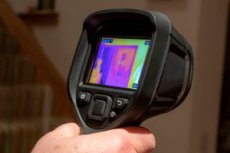Thermal facial scanning and AI accurately predict coronary heart disease
最近審查:14.06.2024

The study was published in BMJ Health & Care Informaticshas found that a combination of facial thermal imaging and artificial intelligence (AI) can accurately predict the presence of coronary artery disease (CHD). This non-invasive, real-time method was found to be more effective than traditional methods and could be introduced into clinical practice to improve diagnostic accuracy and workflow if tested in larger and more ethnically diverse patient populations, the researchers suggest. p>
Current guidelines for diagnosing coronary artery disease rely on estimates of the likelihood of risk factors that are not always accurate or widely applicable, researchers say. While these methods can be complemented by other diagnostic tools such as ECGs, angiograms and blood tests, they are often time-consuming and invasive, the researchers add.
Thermal imaging, which records the distribution and temperature variations on the surface of an object by detecting infrared radiation, is non-invasive. It has proven to be a promising tool for disease assessment as it can identify areas of abnormal circulation and inflammation based on skin temperature patterns.
The emergence of machine learning (AI) technologies with their ability to extract, process and integrate complex information can improve the accuracy and efficiency of thermal imaging diagnostics.
Researchers decided to study the possibility of using thermal imaging in combination with AI to accurately predict the presence of coronary artery disease without the need for invasive and time-consuming methods in 460 people with suspected heart disease. Their average age was 58 years; 126 (27.5%) of them were women.
Thermal imaging images of their faces were taken prior to confirmatory examinations to develop and validate an AI-supported imaging model for detecting coronary artery disease.
A total of 322 participants (70%) had confirmed coronary heart disease. These people tended to be older and more likely to be male. They were also more likely to have lifestyle, clinical, and biochemical risk factors, as well as more frequent use of preventive medications.
Thermal imaging and AI approach was about 13% better at predicting coronary heart disease than preliminary risk assessment using traditional risk factors and clinical signs and symptoms. Among the three most significant thermal indicators, the most influential was the overall temperature difference between the left and right sides of the face, followed by maximum facial temperature and average facial temperature.
Specifically, the average temperature of the left jaw region was the strongest predictor, followed by the temperature difference in the right eye region and the temperature difference between the left and right temples.
The approach also effectively identified traditional risk factors for coronary heart disease: high cholesterol, male gender, smoking, overweight (BMI), fasting glucose, and indicators of inflammation.
The researchers acknowledge the relatively small sample size of their study and the fact that it was conducted at only one center. In addition, all study participants were referred for confirmatory tests for suspected heart disease.
However, the team writes: “The ability of [thermal imaging] to predict based on [coronary heart disease] points to potential future applications and research opportunities... As a biophysiological health assessment method, [it] provides disease-related information beyond traditional clinical measurements, which may improve the assessment of [atherosclerotic cardiovascular disease] and related chronic conditions."
"The non-contact, real-time nature of [it] allows for instantaneous disease assessment at the point of care, which can streamline clinical workflows and save time for important physician and patient decisions. In addition, it has the potential for mass preliminary screening."
The researchers conclude: “Our developed [thermal imaging] prediction models based on advanced [machine learning] technologies showed promising potential compared to current traditional clinical tools.”
"Further studies involving larger numbers of patients and diverse populations are needed to confirm the external validity and generalizability of the current findings."

